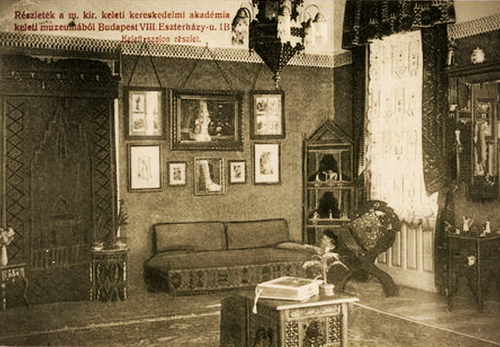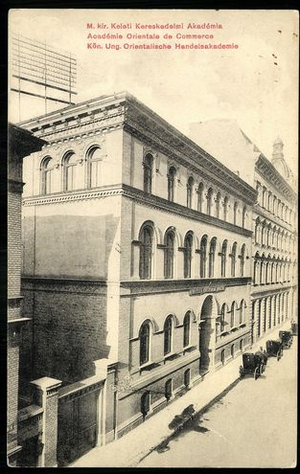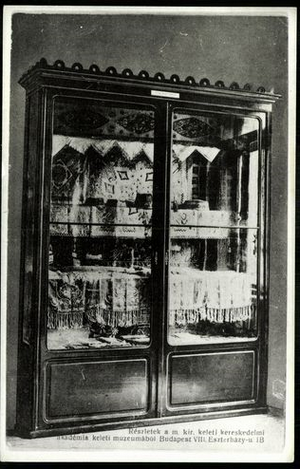The Eastern Museum

The Eastern Museum used to operate at our University’s predecessor institution, the Eastern Trade Academy. What does the name of the institution suggest and why would the Eastern Academy maintain a museum?
The Eastern Museum had not been an antiques treasury, it rather used to be both an ethnographic and product sample collection. Academic training in those times had been very practically-oriented: study tours to the Middle East or to the Balkans used to figure in the curriculum, in fact several of them each academic year. Educational methods used to comprise the collection and the presentation of appropriate visual aids. That is how the ad hoc collection of material started in the 1890s, consisting of useful objects of ethnographic nature (carpets, table covers, eating utensils, ornaments, small items of furniture etc.), industrial products manufactured „in the East” (textile and fabric samples etc.) and perishable goods (like tobacco). Moreover, samples were obtained from products manufactured in Western European countries for „the East” as previous experience had shown that Eastern tastes – i.e. colour schemes, nonfigurative representations, ornamentics– had to be largely met, otherwise the products were not purchased readily or not purchased at all. Best business interests therefore also called for the expansion of the collection. Owing to Ignác Kunos the Academy’s prominent personality, its scholar-director, not only the product sample collection, but the even more valuable ethnographic collection grew as well, with all being well-ordered and housed.
The first objects were collected and brought home by the teachers and the students from the trips. Director Kunos got into touch with the Hungarian trade missions and companies in order to buy the necessary items. The Ministry of Trade allocated an amount of between 500 to 1000 crowns within the budget of the institution to enrich the Eastern Museum’s collection. There were other sources of acquisition, for instance product samples arrived from Bosnia- Hercegovina with the assistance of the Joint Ministry of Finance of the Austro-Hungarian Empire charged with the administration of these provinces.
The situation of the collection that had throughout these years reached a size of several thousand items underwent qualitative change when in 1910 the Eastern Trade Academy moved from Alkotmány Street to a larger building in Esterházy – now Puskin – street. (The University of Technology moved to the campus on the Buda side and the buildings that had been vacated were given to the University of Sciences - today ELTE – and to the Eastern Trade Academy.) The Eastern Museum received 3 rooms on the second floor of the building at 1/b Esterházy Street, the fourth room having been a lecture hall with a projector (!).
Mention must be also made of the phonetic collection that complemented the museal material and was managed by József Balassa linguist. From 1909 István Győrffy ethnographer who later became member of the Hungarian Academy of Sciences was hired to sort and categorize the museal collection. Győrffy was the one to design the cases that were placed in the corridor outside the rooms. The objects, unlike the way in which they would be displayed today, were crammed in the cases.
The Eastern Museum was officially inaugurated 104 years ago, on 15 November 1913. The importance of the event is proved by the fact that two ministers attended: Dr. Béla Jankovich in charge of religion and public education as well as Baron János Harkányi in charge of trade. The most significant collections of the museum in this period included:
- Eastern embroideries and fabrics,
- Ceramics,
- Metal products,
- Folk costumes from the Balkans.
During the Great War the expansion of the collection was largely facilitated by the fact that systematic collection started in the occupied Balkan territories, moreover war prisoners were employed to complement the museal material. In 1916 objects were obtained mainly from Tatar war prisoners detained at the camps of Eger (now called Cheb in the Czech Republic) and near Esztergom in such a way that they themselves crafted the objects and made maquettes of the buildings of their villages. The material of the Eastern Museum, besides being available in the museum building, was also displayed to the general public on Margit Island during a military exhibition. Here a separate pavilion was devoted to the Tatar items. The decay of the collection began after that: not all objects were returned to the museum, and in the hectic years of 1918-19 the Eastern Trade Academy was also restructured. During the Hungarian Soviet Republic the material of the Eastern Museum was first transported to the Ethnographic Department of the Hungarian National Museum, then returned from there in 1920. Unfortunately no handover document was signed in either of the cases. In the same year the Eastern Trade Academy became integrated in the Faculty of Economics of the University of Sciences. In 1924 Professor Pál Teleki consented to the Eastern Museum’s material being definitively handed over to the Ethnographic Department of the Hungarian National Museum (today’s Hungarian Ethnographic Museum). Thus, the collection was moved again to the National Museum and the integrity of the collection of the Eastern Museum was disrupted and the items were redistributed to other collections along a different logic. In 1981 14 items of textile were transferred to the Hungarian Museum of Trade and Catering. These objects are fully identifiable as having belonged to the collection of the Eastern Museum that used to contain over 4000 items.

The building of the Eastern Trade Academy in the 1910-s at 1/b Esterházy (today Puskin) Street

One of the halls of the Eastern Museum in the building of the Eastern Trade Academy after 1913.

One of the display cases of the Eastern Museum in the building of the Eastern Trade Academy after 1913
Source of the photos: https://gallery.hungaricana.hu/hu (as downloaded on 6 November 2017)
Vilmos Zsidi
Head of the Archives at CUB
